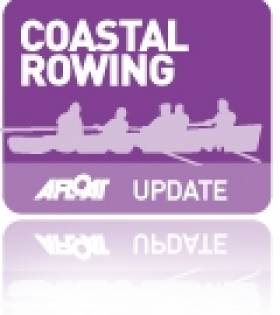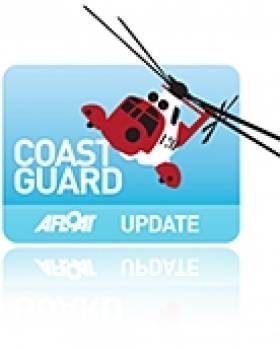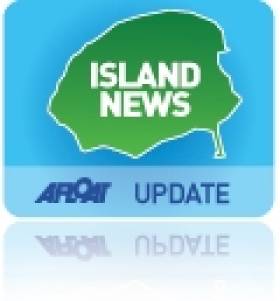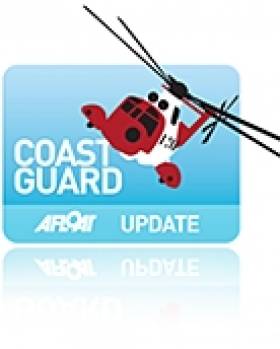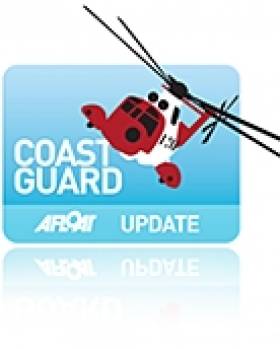Displaying items by tag: Coast Guard
Coast Guard On Long Range Medevac of Injured Russian Crewman
The Shannon based Coast Guard helicopter, R115, evacuated an injured crewman from a Russian vessel, the Armenak Babaev (110metres in length), approximately 150 miles West of Valentia, Co. Kerry last night. The injured man was airlifted at 17.45hrs to Cork Airport for onward transfer to Cork University Hospital for medical attention.
Top Cover communications, which is required for long distance helicopter communications, is being provided by an Air Corps Casa.
The operation is being coordinated by the Coast Guard Rescue Coordination centre in Valentia, who received the request earlier today when the vessel was over 200 miles from the coast. It is understood that the patient suffered burn related injuries in an engine room accident
Howth Coastguard Recruiting Volunteers as Cliff Rescue Climbers, Coastal Search & Boat Crew
The Irish Coast Guard Unit based on the West Pier in Howth Harbour is looking for volunteers.
The Unit is interviewing to fill trainee positions as Cliff Rescue Climbers, Coastal Search and Boat Crew. No experience is necessary.
All training, certifications, and the required personal equipment is provided. Volunteers are expected to live within minutes of Howth, carry a pager 24/7 to be available for callouts, and attend weekly training.
For more information, email [email protected]
Shannon Coast Guard Helicopter Rescues Spanish Trawler Man
The Shannon Coast Guard helicopter has medevac'ed a Spanish crewman from a trawler 120 nautical miles SSW of Mizen Head, in County Cork, one of the extreme points of the island of Ireland.
First Search and Rescue Missions for Welsh Coastguard Helicopter
The new HM Coastguard search and rescue helicopter based at St Athan was sent to its first tasking within an hour of going live at the weekend.
Bristow Helicopters Ltd commenced SAR helicopter operations on behalf of HM Coastguard from the St Athan base on Sunday 4 October at 1pm.
Just 47 minutes later the first job came in, when the crew was sent to help a horse rider who had fallen in a forest in West Wales.
The winchman was lowered to the casualty through a gap in the trees and after the road ambulance arrived, they were moved to a nearby field where the aircraft had landed. The casualty was then flown to Cardiff University Hospital.
Just a few hours later, a second mission came through from the UK Coastguard. At 5.30pm, the crew was asked to help search for a 20ft fishing boat that had run aground about three nautical miles from Swansea.
The crew located the boat on Pendine Sands using the aircraft’s infra-red system and the 80 year-old sailor on board was picked up in good health. He was flown to Pembrey Airfield where he was met by Burry Port Coastguard Rescue Team and members of his family.
Ferryside Independent Rescue Boat towed the vessel back to its mooring at Ferryside.
#currach – The Ballina Quay Regatta fest is making a fantastic return to the quay from June 12th -14th and is set to reignite the nostalgia of years gone by with a spectacular line up featuring All Ireland Currach Racing, boat treasure hunts, fishing competitions, air displays, water skiing and much much more.
The event aims to be a fantastic addition to the already action packed summer calendar in Mayo North and is being presented by the Moy Estuary Boat club, supporting the Ballyglass Lifeboat RNLI service.
After 20 years, the regatta is finally making its grand return and will delight both visitors and locals with an array of magnificient events. Friday night will see a Pirate Treasure Hunt come to the quay, followed by the Rejoice Gospel Choir Concert and the Monarch of the Quay Disco; a perfect introduction to the weekend long entertainment.
The Wild Atlantic Way Discovery Point will host a super adventurous and enjoyable day on Saturday as the Quay will be awash with activity and craic. Stand Up Paddling Board and Kayak races will be taking place all day and there will also be a Fishing Competition in the lead up to the Ceili Mor which will have the entire crowd dancing and jigging as nightime approaches.
On Sunday 14th June, local resident, 92 years young Una Timoney, will cut the ribbon and Mr Chris Reynolds, Director Irish Coast Guard will also officiate at the opening ceremony. This will be followed by Children's Pirate Themed Fancy Dress Parade to the Quay. The Band 2 Brigade will headline on Sunday with an amazing live performace and the final day will also feature a craft fair and a stunning air stunt display, the perfect day out for all the family.
The excitement is surely building, as many of the residents bear fond memories of days gone by and previous regatta festivals in the Quay. Without a doubt, a strong sense of nostalgia surrounds the festival with much anticipation for the return of the regatta, bigger and better than ever before. 4 Team Mixed Relay Swim to Sheaf Throwing, Tug-o-War, and lots more fun and games, the programme of events for the weekend is certainly an impressive one.
Holyhead Coastguard Operations Centre (CGOC) Becomes part of New HM Coastguard Network
#coastguard – Holyhead Coastguard Operations Centre (CGOC) is to become part of the new Coastguard national network for the very first time this week.
Work has been carried out at the search and rescue coordination centre to upgrade the technology and introduce new systems. This means Holyhead CGOC will be connected to the National Maritime Operations Centre (NMOC) in Hampshire and other Coastguard stations around the country, which will be able to offer mutual support during busy periods.
From January 2015, Holyhead CGOC and the new national network will start to take on operations from Liverpool Coastguard.
The changes to Her Majesty's Coastguard will see the NMOC and 10 other CGOCs around the UK work together to manage the workload. There will be no reduction in rescue resources. The availability of Coastguard Rescue Teams, lifeboats, rescue helicopters and other rescue units will be unaffected.
Graham Clark, Maritime Operations Controller at Holyhead CGOC, said:
"The way we deliver the coordination of search and rescue operations on our coast and out at sea is changing. But the public won't notice any difference. If you call 999 and ask for the Coastguard, or issue a mayday broadcast, we will still be here to help you.
"The new national Coastguard network will be able to oversee and assist with operations around the whole of the UK. Here at Holyhead CGOC we're now part of this network, so we can call upon help from our fellow Coastguards elsewhere in the country, and also in turn help them out if needed.
"It's vital to remember though that the rescue teams in your community are unaffected. There will still be the same number of lifeboats, Coastguard Rescue Teams, helicopters and other rescue resources."
The new national network is scheduled to be fully operational by the end of 2015.
Remembering The First Cable Car In Ireland At Garnish
#cablecar – Lehanmore Community Co-Op at Garnish on the Beara Peninsula are planning a re-enactment of what they describe as "the first-ever cable car journey to an island in Ireland." writes Tom MacSweeney.
It will be held at Crow Head on Saturday, September 6 and will involve Kerry Mountain Rescue Team, Castletownbere Coast Guard and Castletownbere RNLI according to Paul O'Shea, the Co-op Chairman,
"The first cable car crossing was by a cable rigged up by a prominent farmer Tadgh Roger O'Sullivan from Scrivogue, Garnish, between the mainland and one of the islands to transport his sheep," Lynette Dewhurst, one of those organising the event, said.
"Tadhg's idea gave the impetus and led to the Dursey cable car, unique in Ireland and which is very well-known today. The re-enactment which we are planning will also be a joint training session between the rescue services. The actual setting-up of the re-enactment will be extremely interesting as ropes will be fired hundreds of feet above the Atlantic to then be moored between the mainland and an island. Members of the rescue service will then travel via the cable."
Shuttle buses will transport spectators from Lehanmore Centre to the demonstration site. As the viewing area is in close proximity to the sea, stewards will guide everybody.
"We are asking spectators to be prepared for all weathers as it is an exposed area and donation buckets will raise funds for Kerry Mountain Rescue. A series of talks will be held at Lehanmore Community Centre hosted by the rescue services, where there will be food and refreshments available throughout the day and the evening, with live music from 7pm till late."
Search for Missing Boy off Holyhead
#coastguard – Coastguards are this afternoon searching for a 12-year-old boy who is believed to have been swept out to sea at Aberffraw.
Holyhead Coastguard received a 999 call at around 12.30 this lunchtime reporting that three people were stuck on rocks in the estuary. Further information then suggested that two men had managed to make it back to shore, plus a young boy; however another youngster was caught in the large waves and swept out to sea.
The Rhosneigr, Holyhead, Bangor and Moelfre Coastguard Rescue Teams along with two Coastguard Sector Managers are currently involved in the search, alongside the RNLI lifeboats from Porthdinllaen, Holyhead, and Trearddur Bay, the search and rescue helicopter from RAF Valley and North Wales Police.
#coastguard –The Irish Coast Guard strongly urges people not to engage in activities that put themselves at risk by diving or swimming in places that are not recognised recreational areas and may pose underwater dangers that are not readily obvious. Swimmers are literally jumping into the unknown, and there may be submerged objects which are not visible and which may cause serious injury.
The Irish Coast Guard advises people to only swim at beaches and waterways where lifeguards are on duty, to obey the safety flags indicating whether it is safe to swim, and to always avoid swimming in locks and weirs.
With the warmer weather over the last few days many people are taking to the water and enjoying outdoor activities. Last year the Irish Coast Guard saw an increase in incidents, and incidents are up again this year. The Coast Guard is urging everyone to heed the advice and enjoy the water and coastal activities in a safe manner throughout the summer.
Speaking ahead of the weekend Declan Geoghegan, Manager at the Irish Coast Guard, said: 'With the advent of good weather it is extremely important that people take extra precaution with regard to personal safety when engaging in water activities, especially where young children are concerned'.
Swimming
Only swim at beaches and waterways that have lifeguards on duty and pay attention to the safety flags, avoid locks and weirs. Ask the Lifeguard for advice about safety and water conditions and adhere to their instructions.
Never go out on the water, including rivers and lakes, having consumed alcohol.
Be able to swim. Get the proper training to stay safe.
Never go out alone.
Familiarise yourself with the local area, be aware of your own capabilities.
Swim parallel to the shore and not in deep water.
Keep warm before and after swimming.
Have a means of alerting the emergency services.
Avoid using inflatable toys, such as lilos and rubber rings, on the water.
Cliff Walking
There is safety in numbers, so never be alone if possible. Let somebody know when and where you are going and what time you will be back. Stay well away from the cliff edge, both top and bottom. Don't attempt to rescue people or pets if they fall over the edge. If assistance is required dial 112/999 and ask for the Coast Guard.
One Man & His Dog Rescued From Yacht
#coastguard – A Coastguard-coordinated rescue in the Bristol Channel last night (Thursday 24th) has underlined the importance of ensuring a vessel is seaworthy and properly equipped before taking to the waves.
Just before midnight, the Swansea Maritime Rescue Co-ordination Centre were contacted by the police who had received a call from a mariner, accompanied only by his dog, whose 17ft sailing boat had become stranded mid-Channel, just south of Lundy Island, after the outboard motor failed.
Upon further investigation it was discovered that the vessel was one of the least seaworthy that Swansea Coastguards had encountered in a good while: its hull was leaking, the mast was missing, with an old windsurfing rig serving as a poor substitute; the boat had no lights, no VHF radio – the sailor contacted the emergency services on a mobile phone – and his GPS device wasn't working, so he was unable to give his position. Coastguards had to use onshore telecommunications beacons to estimate his location to within 30km.
The optimistic voyager, who had also neglected to carry any charts, informed Coastguards that he was en route to the Hebrides, having set out from Instow, North Devon.
Coastguards had to use onshore telecommunications beacons to estimate his position to within 30km. This enabled them to task the search and rescue helicopter from Chivenor who spent two hours searching for a boat in the dark with no lights on, and just after four in the morning the sailor and canine companion were winched from the boat. RNLI's Appledore lifeboat was tasked to recover the vessel from a position 2.5 miles SSW of Lundy so that it was no longer a danger to shipping in the busy Bristol Channel. The volunteer lifeboat crew returned to station at 0915 in the morning, ready for a full day's work.
Bernie Kemble, Swansea Coastguard Watch Officer, said: "So many things were wrong with this gentleman's boat and lack of preparation that the situation was almost comical. He had taken to sea in what was effectively a leaky fibreglass hull, without even the most basic communications and safety equipment.
"Thankfully, weather conditions were calm, he was avoided by other vessels in the area and he was able to use the only piece of communications equipment he had to hand – his mobile phone – to raise the alarm. However, the situation could have been far more serious and he and his dog were lucky that they were rescued promptly.
"We would remind anyone in trouble at sea or on the coast to dial 999 and ask for the Coastguard."
The sailor and his dog were both reported to be unharmed by their ordeal.


























